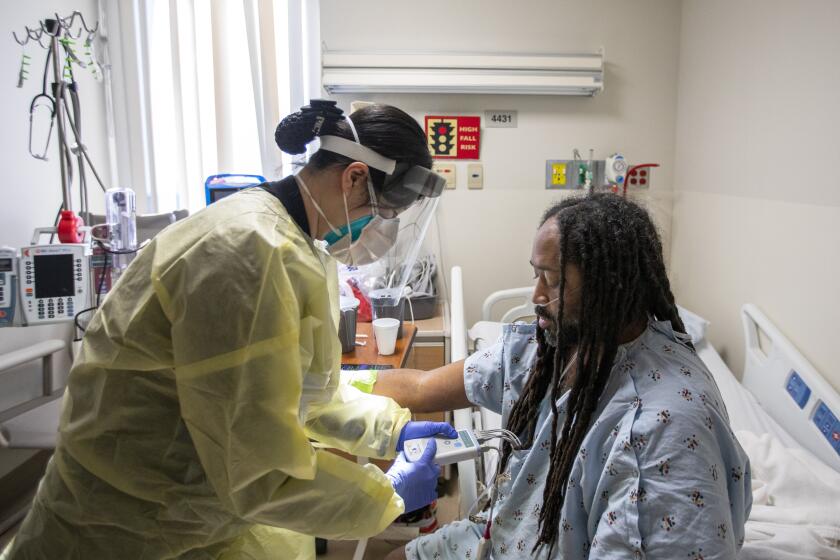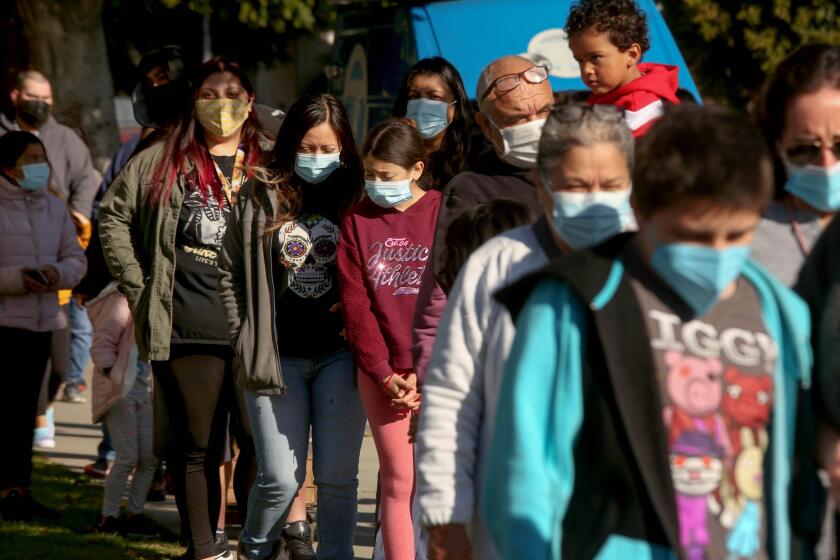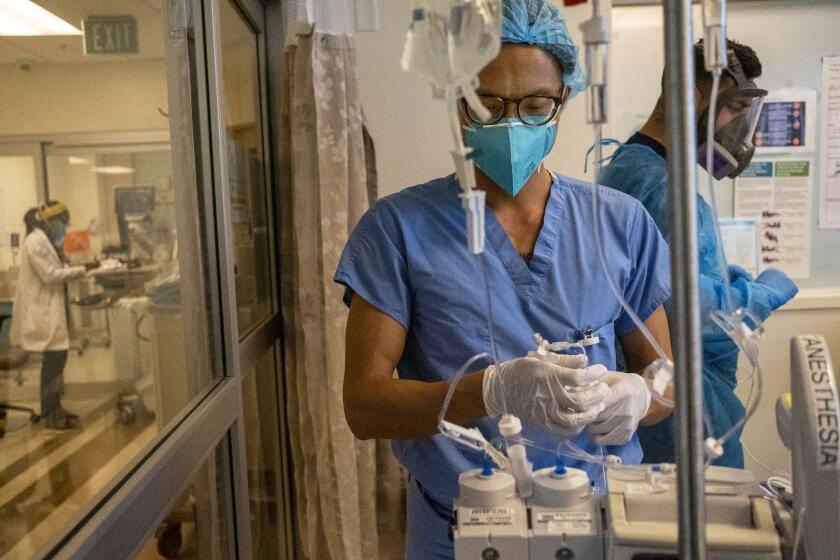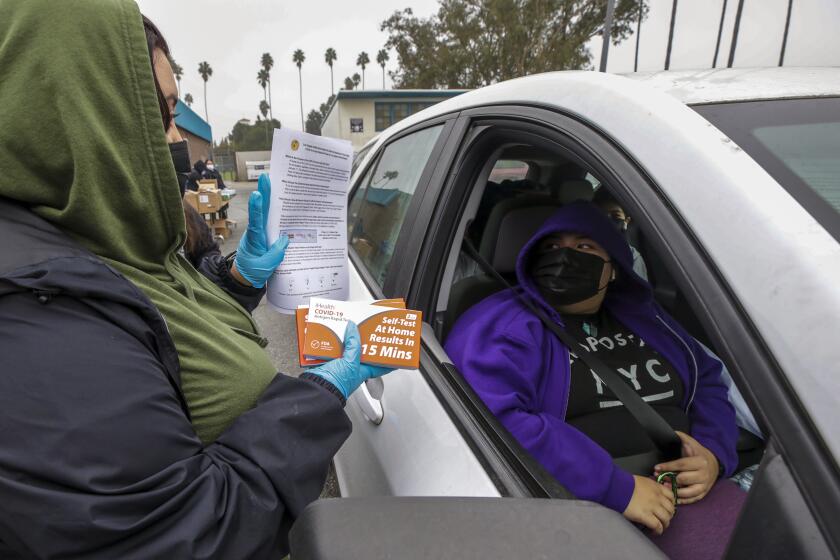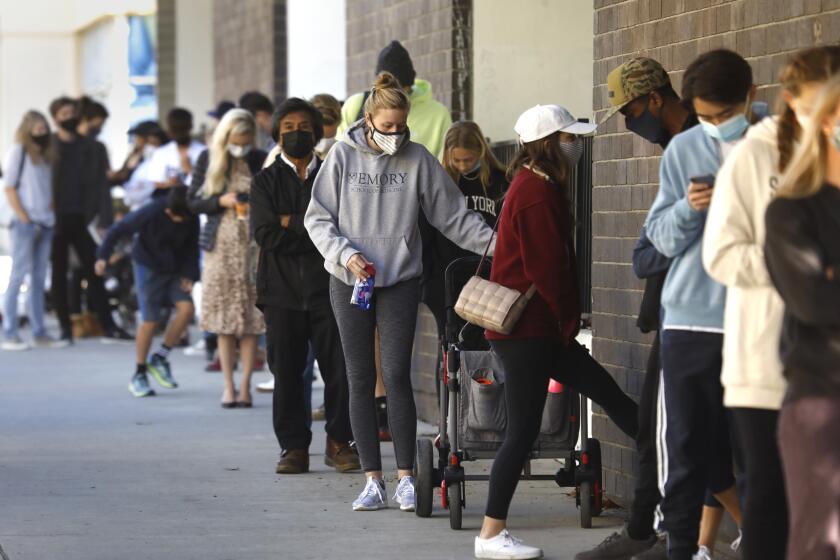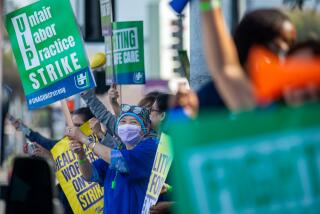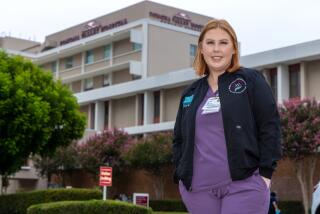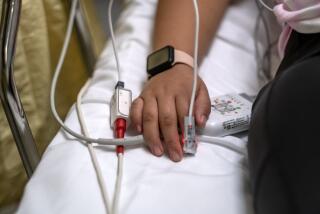As hospitals reel, California tells coronavirus-positive medical workers to stay on the job
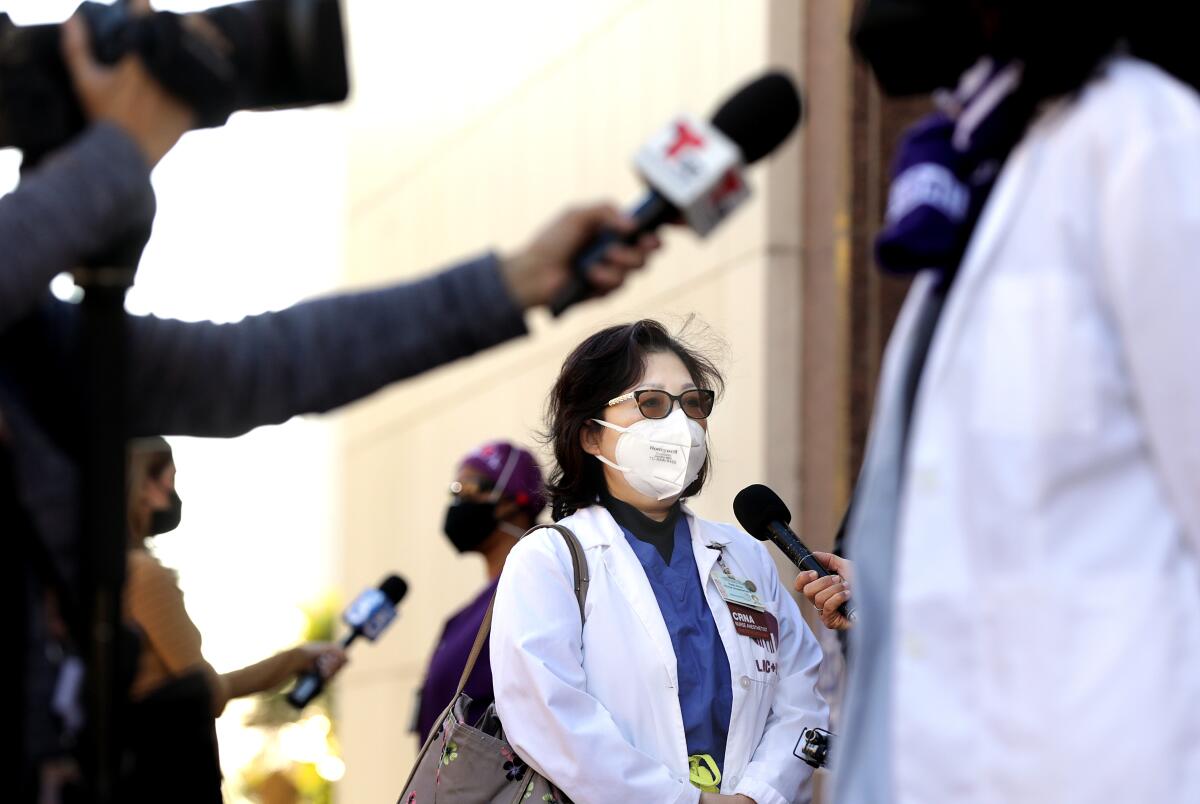
Daylong waits in the emergency room. No one to answer the phones. No one to take out the trash. And more patients arriving each day.
That’s the scene playing out at some hospitals across Southern California as the Omicron-fueled surge of COVID-19 contributes to a crippling shortage of doctors, nurses and other healthcare workers. While Omicron is causing significantly fewer serious illnesses than last year’s winter surge, the unprecedented number of people becoming infected has left the medical infrastructure on edge.
State officials are attempting to address California’s staffing shortage through a sweeping policy change that allows asymptomatic healthcare workers who have tested positive for the coronavirus to return to work immediately. The policy, set to remain in place through Feb. 1, is designed to keep many healthcare workers on the job at a time when hospitals are expecting more patients.
Some experts say California’s stance is an unorthodox yet necessary solution to a difficult problem. Yet many healthcare workers and community members say the policy is not only ill-advised, it’s potentially dangerous.
“The situation just feels so hopeless,” said Erin McIntosh, a rapid-response nurse at Riverside Community Hospital. “I went into healthcare wanting to help people, but now I’m the vector. Someone is coming to me in their time of need, and I could potentially be passing them COVID.”
L.A. County has identified the 20 most hard-hit emergency rooms, and county employees have been dispatched to the top 10 — all privately run hospitals.
McIntosh said Monday that more than 300 nurses and many other staff members at the hospital are out sick because of COVID-19, and that those who remain are stretched to the brink. Some nurses are having to take on far too many patients, while others can’t even find an assistant to help bring patients to the bathroom.
But potentially exposing patients to hospital workers who have tested positive — even if the workers are not feeling ill or showing symptoms — is not the solution, McIntosh said. Already, she has heard of coronavirus-positive workers attending to women in labor, chemotherapy patients and patients in neonatal intensive care.
“Now they’re even more vulnerable,” she said.
The California Department of Public Health said hospitals are reaching capacity, and the decision was driven in large part by staffing shortages making it difficult to provide essential care.
“Given those conditions, the department is providing temporary flexibility to help hospitals and emergency services providers respond to an unprecedented surge and staffing shortages,” the agency said.
According to the guidelines, hospitals should exhaust all other options before resorting to the new policy, and workers who have tested positive for the virus should “preferably be assigned to work with COVID-19 positive patients.” The workers must always wear N95 masks.
In general, tests are able to reveal an Omicron infection, but enough virus needs to have reproduced and appear at sufficiently high levels in the nose or saliva to be detectable, health officials say.
The announcement was met with outrage by many in the healthcare industry.
The decision is “irresponsible and a huge mistake that will jeopardize everyone’s health,” said Rosanna Mendez, executive director of SEIU 121RN, a union representing workers in Southern California. “This plan is unscientific and dangerous, and, given what we know about the transmissibility of the new variant, we believe it will put healthcare workers and patients at unnecessary risk.”
But some experts say that patients who are seen by asymptomatic workers following proper protocols are relatively safe, and that the policy — while not perfect — is a necessary stopgap to keep the system from collapsing.
“Is the situation ideal? No,” said Dr. Robert-Kim Farley, an epidemiologist and infectious-diseases expert at the UCLA Fielding School of Public Health. “Is it the lesser of the two evils of having no one to care for patients, versus having staff caring for them that may have COVID? Yes, it’s the lesser of two evils.”
Kim-Farley said the policy is a recognition of the significant strain hospitals are experiencing amid an increased number of patients and decreased number of staff. The chances of transmission from an asymptomatic worker are minimal, he said, particularly since he or she would be practicing precautions, including wearing high-grade medical masks.
But, he added, “when patient loads start to drop, and also staff shortages are reduced, we should move away from this extraordinary approach.”
Though the severity of COVID-19 illness at hospitals is lower than last winter’s surge, sick staffers and massive demand for testing are causing problems.
The situation in many hospitals already seems untenable, and some healthcare workers said the new policy is creating more stress for an already overloaded workforce. Others said it was hypocritical of the state to ask coronavirus-positive staffers to report for duty after instituting a vaccine mandate that cost some workers their jobs.
Gabriel Montoya, an emergency medical technician at Kaiser Downey, said when he arrived at work one day last week, there were still patients in the waiting room who had been sitting there when he left the night before.
All of the emergency department’s beds — including 80 in the ER and 20 in a tent outside — have been full since the start of the year, he said. Housekeepers, environmental service workers, delivery workers and even the lab workers who process COVID-19 tests are out sick.
Yet the policy change doesn’t account for the realities of daily patient care, which often necessitate “working inches away from each other,” he said. Instead of solving the problem, it could exacerbate it.
“You’re going to get more people sick,” Montoya said. “That’s what’s going to happen.”
What’s more, he said the change exposes not only patients and workers, but also their loved ones. Montoya cares for his mother at home.
“Workers are feeling like they’re being devalued — their own lives, their families’ lives — are being disrespected,” he said. “And then they’re being retraumatized by again having to go into the workplace facing obstacles that we didn’t have to face the day before.”
A spokesman for Kaiser said the company is adhering to guidelines from the Centers for Disease Control and Prevention while it reviews the new state policy. The CDC currently recommends that asymptomatic healthcare workers return to work after seven days with a negative test, although it, too, allows for the removal of those restrictions during times of crisis.
L.A. County health officials are urging that gatherings be postponed for a few weeks as COVID case rates skyrocket.
Dr. Joanne Spetz, director of the Philip R. Lee Institute for Health Policy Studies at UC San Francisco, said the newness of Omicron makes it difficult to compare the risk of staffing shortages to the risk of patient exposure, as there is little data about the new variant with which to work.
One thing that is clear, however, is that understaffing poses a substantial risk to patients. Research has found that short staffing results in more deaths, more morbidity and more accidents and errors, she said.
“Hospitals are really stuck between a rock and a hard place, in that you really do have these staffing shortages and you have volumes of patients increasing,” Spetz said. “What do you do?”
Some hospitals, including Los Angeles County-USC — the largest public hospital in L.A. — are weighing the options. The L.A. County Department of Health Services is reviewing the proposed guidelines but has not yet issued an official policy, hospital officials said in an email.
“As always, when addressing any changes to our expected practices, L.A. County Department of Health Services will make adjustments that follow data-driven science and uphold our responsibility to the well-being of our staff, patients and the communities we serve,” they said.
California Health and Human Services Secretary Dr. Mark Ghaly said similarly Monday that the guidelines are not a requirement and asked healthcare systems to use the measure only if they’ve explored all other options.
With an average of nearly 115,000 people being tested each day over the last seven days, more than 20% of people are testing positive for the virus.
But Tuesday, nurses and representatives with the SEIU 721 union gathered outside the Los Angeles County Board of Supervisors meeting in downtown to L.A. to speak out against the measure. The California Nurses Assn. said it was similarly planning a “day of action” Thursday to condemn the state’s decision.
Dr. Ileana Meza, an SEIU union chair and nurse practitioner at L.A. County-USC, said the staffing situation at the hospital was dire. When she arrived at work Monday, the parking lot looked empty because so many people were out sick. Thirty emergency room nurses and 40 operating room nurses called in sick last week, and some patients are waiting up to 20 hours for admission.
But there are other, safer solutions to the staffing crisis than asking coronavirus-positive healthcare workers to tend to patients, she said, including investing in more staffing, making efforts to improve compensation and morale, tightening visitor controls, canceling all non-elective and non-critical procedures and focusing on telemedicine.
“With this new decision, if you come to the hospital for a routine check, you may be checked in by a clerk who’s positive, you may have your vitals taken by a nurse who’s positive, you might be seen by a doctor who’s positive,” Meza said.
“That means you’re coming into the facility without the virus and you may contract the virus,” she said. “This is not the way to drive this pandemic down.”
Times staff writer Gregory Yee contributed to this report.
More to Read
Start your day right
Sign up for Essential California for news, features and recommendations from the L.A. Times and beyond in your inbox six days a week.
You may occasionally receive promotional content from the Los Angeles Times.
